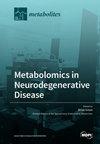使用二维 GC-GC-MS 平台的非靶向代谢组学方法在区分复发性和进行性多发性硬化症方面的实用性
IF 3.4
3区 生物学
Q2 BIOCHEMISTRY & MOLECULAR BIOLOGY
引用次数: 0
摘要
多发性硬化症(MS)是青壮年最常见的中枢神经系统(CNS)炎症性神经退行性疾病,会导致进行性神经功能缺陷。复发-缓解表型(RRMS)是多发性硬化症最常见的病程,最终发展为继发性进展型多发性硬化症(SPMS),而原发性进展型多发性硬化症(PPMS)是一种随着时间推移逐渐恶化且无缓解的多发性硬化症。关于能否根据血清代谢物谱的改变将复发性多发性硬化症与进展性多发性硬化症或健康受试者(HS)区分开来,目前尚存在知识空白。在这项研究中,我们利用二维 GC-GC-MS 平台进行了全球非靶向代谢组学研究,以确定 RRMS、PPMS 和 HS 之间代谢物的变化。我们分析了 RRMS(41 人)、PPMS(31 人)和 HS(91 人)患者血清中的 235 种代谢物。对 RRMS 和 HS 患者进行比较后发现,有 22 种代谢物发生了明显变化,P < 0.05(假发现率 [FDR] = 0.3)。PPMS 和 HS 的比较显示,28 个代谢物发生了改变,p < 0.05(FDR = 0.2)。使用 MetaboAnalyst 进行的通路分析显示,在 RRMS 和 PPMS 中,有四种代谢通路发生了富集(超几何检验 p <0.05):(1)半乳糖代谢;(2)氨基糖和核苷酸糖代谢;(3)苯丙氨酸、酪氨酸和色氨酸生物合成;以及(4)氨基酰-tRNA生物合成。Qiagen IPA富集测试发现,在RRMS组与HS组中,硫酸酯酶2(SULF2)(p = 0.0033)和整合素亚基β1结合蛋白1(ITGB1BP1)(p = 0.0067)基因是代谢物改变的上游调控因子。然而,在 PPMS 与 HS 的比较中,缬氨酸富集于脑细胞的神经变性(p = 0.05),而十七酸、α-酮异己酸和甘油参与了中枢神经系统的炎症(p = 0.03)。总之,我们的研究表明,RRMS和PPMS可能以独特的代谢物改变形式提供代谢指纹,用于区分MS疾病和HS,并有可能为MS等进行性自身免疫性疾病构建代谢物面板。本文章由计算机程序翻译,如有差异,请以英文原文为准。
Utility of an Untargeted Metabolomics Approach Using a 2D GC-GC-MS Platform to Distinguish Relapsing and Progressive Multiple Sclerosis
Multiple sclerosis (MS) is the most common inflammatory neurodegenerative disease of the central nervous system (CNS) in young adults and results in progressive neurological defects. The relapsing-remitting phenotype (RRMS) is the most common disease course in MS, which ultimately progresses to secondary progressive MS (SPMS), while primary progressive MS (PPMS) is a type of MS that worsens gradually over time without remissions. There is a gap in knowledge regarding whether the relapsing form can be distinguished from the progressive course, or healthy subjects (HS) based on an altered serum metabolite profile. In this study, we performed global untargeted metabolomics with the 2D GC-GC-MS platform to identify altered metabolites between RRMS, PPMS, and HS. We profiled 235 metabolites in the serum of patients with RRMS (n = 41), PPMS (n = 31), and HS (n = 91). A comparison of RRMS and HS patients revealed 22 significantly altered metabolites at p < 0.05 (false-discovery rate [FDR] = 0.3). The PPMS and HS comparisons revealed 28 altered metabolites at p < 0.05 (FDR = 0.2). Pathway analysis using MetaboAnalyst revealed enrichment of four metabolic pathways in both RRMS and PPMS (hypergeometric test p < 0.05): (1) galactose metabolism; (2) amino sugar and nucleotide sugar metabolism; (3) phenylalanine, tyrosine, and tryptophan biosynthesis; and (4) aminoacyl-tRNA biosynthesis. The Qiagen IPA enrichment test identified the sulfatase 2 (SULF2) (p = 0.0033) and integrin subunit beta 1 binding protein 1 (ITGB1BP1) (p = 0.0067) genes as upstream regulators of altered metabolites in the RRMS vs. HS groups. However, in the PPMS vs. HS comparison, valine was enriched in the neurodegeneration of brain cells (p = 0.05), and heptadecanoic acid, alpha-ketoisocaproic acid, and glycerol participated in inflammation in the CNS (p = 0.03). Overall, our study suggests that RRMS and PPMS may contribute metabolic fingerprints in the form of unique altered metabolites for discriminating MS disease from HS, with the potential for constructing a metabolite panel for progressive autoimmune diseases such as MS.
求助全文
通过发布文献求助,成功后即可免费获取论文全文。
去求助
来源期刊

Metabolites
Biochemistry, Genetics and Molecular Biology-Molecular Biology
CiteScore
5.70
自引率
7.30%
发文量
1070
审稿时长
17.17 days
期刊介绍:
Metabolites (ISSN 2218-1989) is an international, peer-reviewed open access journal of metabolism and metabolomics. Metabolites publishes original research articles and review articles in all molecular aspects of metabolism relevant to the fields of metabolomics, metabolic biochemistry, computational and systems biology, biotechnology and medicine, with a particular focus on the biological roles of metabolites and small molecule biomarkers. Metabolites encourages scientists to publish their experimental and theoretical results in as much detail as possible. Therefore, there is no restriction on article length. Sufficient experimental details must be provided to enable the results to be accurately reproduced. Electronic material representing additional figures, materials and methods explanation, or supporting results and evidence can be submitted with the main manuscript as supplementary material.
 求助内容:
求助内容: 应助结果提醒方式:
应助结果提醒方式:


